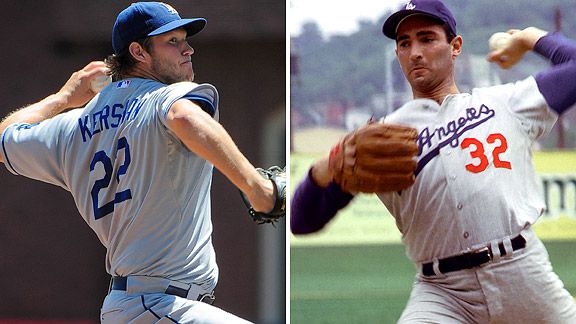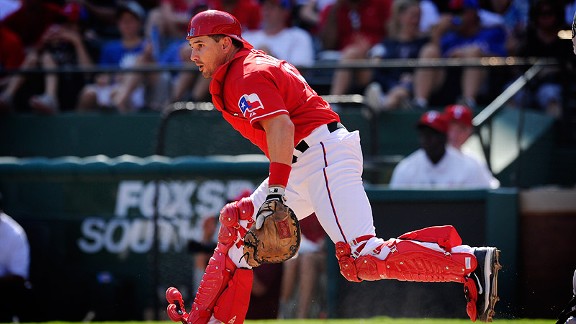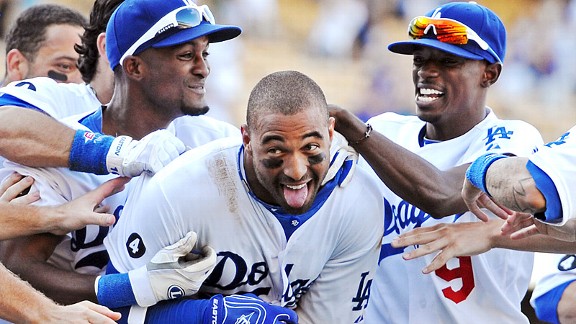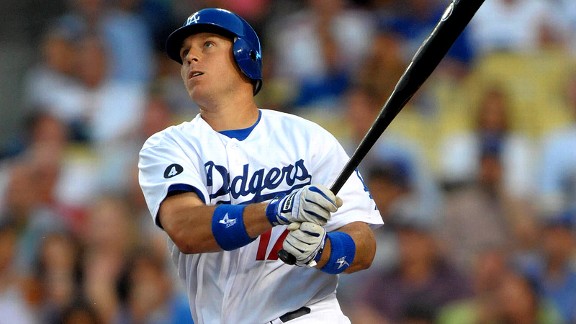 Getty Images
Getty ImagesBrothers in arms …
Baseball is a team sport that honors individual accomplishments like no other, so much so that when I ask this question …
Who is more revered in Los Angeles, the 1963 and 1965 world champion Dodgers, or Sandy Koufax?
… the answer, I believe, is surely Koufax.
It’s a choice between heaven and nirvana, a hypothetical beyond the heretical, one you need not fret over. You never have to have one without the other. But while those Dodgers were angels, Koufax is a god.
So when Clayton Kershaw draws comparisons to Koufax, it is no small matter. It is a very large matter, larger in some ways than the Dodgers’ passing another year without becoming world champions, and larger certainly than Kershaw’s fate in the 2011 National League Cy Young Award balloting.
Don’t misunderstand me — Kershaw winning today’s award is a big deal, a wonderful, rip-roaring accomplishment, and yet at the same time, the celebration of his victory is about 1/1,000,000,000th of how nuts Dodger fans will go the next time they’re the last team to leave the field at the end of a season. But if Kershaw turns about to be another Koufax, a living, breathing Zeus throwing lightning bolts from his pitching Olympus, that’s going to resonate through history even more.
Koufax is a Los Angeles Dodger who is honored like no other, so much so that when I ask this question …
Is Kershaw going to be even better than Koufax?
… the answer, I believe, may cause heart palpitations across an entire Dodgers universe.
Through age 23, Kershaw has 716 1/3 innings, 745 strikeouts, a WHIP of 1.173 and a
park/era-adjusted ERA, according to Baseball-Reference.com, of 135.
Through age 23, Koufax had 516 2/3 innings, 486 strikeouts, a WHIP of 1.461 and a
park/era-adjusted ERA, according to Baseball-Reference.com, of 100.
At the age that Kershaw became a Cy Young Award winner, Koufax had a 4.05 ERA in 153 1/3 innings in which he walked 92. Koufax didn’t have a significantly above-average season until he was 25 and wasn’t ever mentioned on a Cy Young ballot until he won the award for the first time at age 27.
Comparisons are never perfect — Jane Leavy’s Koufax biography is one of several sources that describes manager Walter Alston’s ambivalence about using the young Koufax, leaving open the possibility that Alston hampered Koufax’s early development. And surely, there’s no guarantee that even though Kershaw is better than Koufax was at age 23, he’ll still be better from ages 26-30, when Koufax, at the height of his astonishment, pitched 1,377 innings, struck out 1,444 with an ERA+ of 167.
Who knows if Kershaw will ever reach a World Series, let alone pitch in four of them with a 0.95 ERA and 61 strikeouts in 57 innings, including back-to-back shutouts with 10 strikeouts apiece with only two days in between?
But in the race across time between Koufax and Kershaw, Koufax is the tortoise, and Kershaw is the hare, except that he’s a hare with a head on his shoulders, not to mention better medical.
Scouts told Tony Jackson of ESPNLosAngeles.com all the different ways Kershaw can still improve. “That change[up] is still a work in progress,” one scout said. “The curveball has a chance to be really good. I had his fastball from 89 [mph] all the way up to 96. So I don’t think he is where he is going to be yet, not anywhere near it.”
Koufax won three Cy Young Awards and finished in third place for another. Already, Kershaw is more than a quarter of the way there. He’s 23, and should remain a Dodger past Koufax’s age of retirement, 30. Kershaw is the kind of pitcher who people will make pilgrimages to see for decades after he has left the playing field, who can carry a franchise’s legacy even if the franchise itself is too weak to build upon its own.
It could all go haywire in an instant, so easily that when I ask this question …
Can Kershaw do it over the long haul?
… the answer, I believe, is let’s see. Yes, please, let’s see.
* * *
We saw this coming. Looking ahead to the 2011 season in February, we could say the following:
… He’s not a Fernando or a Sandy. Not even a Piazza or (for that brief, baggage-heavy moment) a Manny. He’s not a “Bulldog” or a “Game Over.”
He’s still a plain old guy with two plain old names, with a humble personality to match — a wolf in sheepish clothing.
If you say Clayton Kershaw is the best player on the Dodgers, you won’t necessarily get an argument, but you might get a shrug. With disappointment still dripping from the team’s 2010 season, “best player on the Dodgers” won’t earn you much more than a patronizing pat on the head, maybe an extra juice box after practice. For now, anyway.
Sometimes it happens practically overnight, the way it seemed to with Fernando Valenzuela and Mike Piazza. Other times — more often, really — it’s years in the making, as with Sandy Koufax, Orel Hershiser and Eric Gagne.
Either way, there’s an explosion within reach for Kershaw — oh, you better believe there is. He turns 23 on March 19, and soon after, he might turn Dodger Stadium back into a place where fans are racing through the crowds for their seats, the way they did for those transcendent heroes of the recent or distant past, for no other reason than to drool over his next pitch or exult in his supremacy. …
Kershaw’s 2010 season had been very, very good — a 2.91 ERA and 212 strikeouts in 204 1/3 innings — so good that if he had regressed in 2011, he still could have had a very good season. Despite shutting out San Francisco over seven innings on Opening Day, Kershaw’s first month of 2011 looked like it would fall into that groove. Even with 41 strikeouts in 38 1/3 innings, inconsistency left him holding a 3.52 ERA at the end of April.
May was our first sign that something really special was within reach. He started six games and allowed eight runs, pitching 40 2/3 innings with a 1.77 ERA and 46 strikeouts, finishing the month with a two-hit, 10-strikeout shutout of Florida in which neither hit was a hard one.
But June started with two absolutely carking games. (Note: “Carking” is both archaic and a bit inaccurate, but it sounds exactly like the word I want.) On June 4 at Cincinnati, Kershaw had faced the minimum number of batters in the sixth inning, only to have things slip away for six runs over the next two innings. Five days later, Kershaw virtually repeated himself in Colorado. His ERA zipped back up to 3.44, and “learning experience” again elbowed its way into the picture.
Now here’s where things really get fun.
Over his final 19 starts of the year, Kershaw allowed only 24 earned runs. He pitched 141 2/3 innings with 146 strikeouts and a 1.52 ERA. Opponents had a .236 on-base percentage and .285 slugging percentage.
Over his final nine starts of the year, Kershaw allowed only seven earned runs. He pitched 65 2/3 innings with 64 strikeouts and a 0.96 ERA. Opponents had a .225 on-base percentage and .274 slugging percentage.
There were pitches he would have liked to have had back, but not many, not many at all.
He pitched another two-hit shutout June 20. He need only eight pitches for a perfect fifth inning with a strikeout in the All-Star Game. He struck out 12 in eight shutout innings on July 20 to beat Tim Lincecum for the second time in 2011, struck out nine in eight innings while allowing only an unearned run to beat Lincecum again Sept. 9, then earned his fourth win over Lincecum (and 20th of the season) on Sept. 20 by allowing one earned run in 7 1/3 innings.
With a triumphant final outing against San Diego on Sept. 25, Kershaw (21-50 ended his year with a league-leading 248 strikeouts, 0.977 WHIP and 2.28 ERA and an adjusted ERA of 163 that was a hair behind Roy Halladay’s 164.
Should Halladay, who pitched home games in a more challenging park, have won the Cy Young? If you think so, I won’t try to dissuade you. I’ll just relax with this.
Halladay, 34, is a true Hall of Fame candidate, practically the gold standard for pitching over the past four seasons with by far the best adjusted ERA during that span. When Halladay was 23, he allowed 80 earned runs in 67 2/3 innings for a 10.64 ERA.
It was a close call for who should be called the best pitcher in the NL today. But one, just one, is so amazing at such a young age, that when I ask this question …
What pitcher in baseball would you most like to have right now?
… only one answer should come to your mind: Clayton Edward Kershaw.











